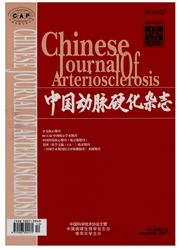

 中文摘要:
中文摘要:
目的 研究有氧运动对老年自发性高血压大鼠(SHR)内皮功能的影响,探讨氧化应激在其中的作用机制。方法 实验选用24只16月龄雄性SHR大鼠,随机分为高血压安静组(SHR-C,n=12)、高血压运动组(SHR-EX,n=12);选用24只同龄雄性正常血压大鼠(WKY),随机分为正常血压安静组(WKY-C,n=12)、正常血压运动组(WKY-EX,n=12)。运动组以16~18 m/min进行8周跑台运动(0°slope,5 d/w,60 min/d),安静组不进行任何运动干预。8周训练末进行血压测定、离体肠系膜动脉张力测定、氧化应激相关指标和一氧化氮(NO)含量检测。结果SHR-EX组收缩压显著低于SHR-C组(P〈0.05),而WKY-EX组收缩压与WKY-C组无显著性差异(P〉0.05)。SHR-C组血清丙二醛(MDA)含量(11.8±1.0μmol/L)显著高于WKY-C组(7.2±0.3μmol/L,P〈0.05),而SHR-EX组血清丙二醛(MDA)含量(7.9±0.3μmol/L)显著低于SHR-C组(P〈0.05);各组间主要的抗氧化物酶谷胱甘肽过氧化物酶和过氧化物歧化酶没有显著差异(P〉0.05)。SHR-C组NE诱发的血管收缩反应(153.2±1.9%KMAX)显著高于WKY-C组(120.2±5.6%KMAX,P〈0.05),SHR-EX组NE诱发的血管收缩反应(136.0±1.8%KMAX)显著低于SHR-C组(P〈0.05),但WKY-EX组NE诱发的血管收缩反应(143.9±4.3%KMAX)仍显著高于WKY-C组(P〈005);SHR-C组内皮依赖性血管舒张(50.2±2.8%NE)显著小于WKY-C组(100.1±0.6%NE,P〈0.05),SHR-EX组内皮依赖性血管舒张(97.0±1.5%NE)显著高于SHR-C组(P〈0.05)。离体微血管环加入NADPH氧化酶抑制剂Apocynin预孵育15 min后,SHR-C组血管内皮最大舒张(98.6±1.3%NE)显著增高(P〈0.05)。SHR-C组NO依赖性血管舒张(25.5%±2.3%)显著低于WKY-C组(85.2%±0.7%,P〈0.01),SHR-EX组和WKY-EX组NO依赖性血管舒张(86.8%±3.4%和98.8%±1.5%)显著高于对应的安静组(P〈0.05)。结论 长期有氧运动抑制由衰老和/或高血压诱导的氧化?
 英文摘要:
英文摘要:
Aim To explore the effect of aerobic exercise on endothelial function in elderly spontaneously hyper-tensive rats (SHR), and the oxidative stress mechanism. Methods Sixteen-month-old male spontaneously hypertensive rats ( n = 24) and male Wistar Kyoto rats ( WKY, n = 24) with the same age were selected. Wistar Kyoto rats and spontaneously hypertensive rats were randomly assigned to sedentary control groups (WKY-C and SHR-C) and exer-cise-trained groups (WKY-EX and SHR-EX), seperately. The animals in exercise-trained groups ran on a motor treadmill (0° slope, 5 d/w, 60 min/d) at 16- 18 m/min for 8 weeks. Blood pressure was examined by non-invasive methods, isolated vessel rings were applied to evaluate vasomotor response, plasma samples were used for measurement of NO level and relative oxidative stress markers. Results The systolic blood pressure was significantly lower in SHR-EX group than that in SI-IR-C group (P〈0.05). Serum malondialdehyde (MDA) in SHR-EX group (7.9±0.3μmol/L) was lower than that in SHR-C group ( 11.8±1.0μmoL/L, P〈0.05), serum MDA in SHR-C group was significantly higher than that in WKY-C group ( 7.2±0.3μmol/L, P〈 0.05 ). Antioxidant enzymes including glutathione peroxidase ( GSH-PX ) and superoxide dismutase (SOD), however, there was no significant difference between four groups. Exercise had significant changes of NE-induced vascular contraction in SHR ( SHR-EX : 136.0±1.8 % KMAx ; SHR-C : 153.2±1.9 % KMAx , P〈 0. 05). Compared with SHR-C group, NE-induced vascular constriction in WKY-C group ( 120.2±5.6 %KMAx, P〈0.05) were significantly lower, and that in WKY-EX group ( 143.9±4.3 %KMAX ) were significantly higher than that in WKY-C group (P〈0.05). Endothelium-dependent vasodilaton in SHR-C group (50.2±2.8 %NE) was significantly lower than that in WKY-C group ( 100.1±0.6 %NE, P〈0.05), endothelium-dependent vasodilaton in SHR-EX group (97.0±1.5 % NE) was significantly higher than t
 同期刊论文项目
同期刊论文项目
 同项目期刊论文
同项目期刊论文
 期刊信息
期刊信息
